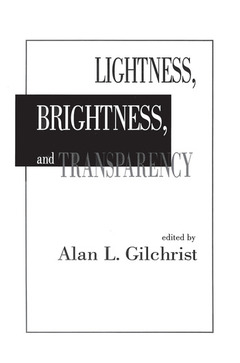Description
Lightness, Brightness and Transparency
Language: English
Subject for Lightness, Brightness and Transparency:
Keywords
contrast; surface; colors; matches; simultaneous; constancy; coding; color; test; patches; Luminance Gradients; Lightness Constancy; Brightness Contrast; Brightness Matches; Simultaneous Brightness Contrast; Crispening Effect; Luminance Ratios; Illumination Gradient; Color Constancy; Intrinsic Images; Surface Perception; Filter Model; Intrinsics Computation; Brightness Gradient; Perceived Transparency; Luminance Version; Proximal Stimulus; Luminance Profile; Background Reflectances; Single Illuminant; Background Luminance; Surface Color Perception; Layer Illumination; Homogeneous Gray; Chromatic Adaptation
· 15.2x22.9 cm · Paperback
Description
/li>Contents
/li>Readership
/li>Biography
/li>
This volume deals with the visual perception of lightness, brightness, and transparency of surfaces, both under minimal laboratory conditions and in complex images typical of everyday life. Each chapter analyzes the challenging problem of how a pattern of light intensities on the retina is transformed into the visual experience of varying shades of grey, transparent surfaces, and light and shadow. One important theme which unifies the group of contributions is the recognition that the perception of surface lightness is rooted fundamentally in the encoding of relative intensities of light within the retinal image, not intensities per se. A second important unifying theme is an appreciation of the multiple dimensions of the visual experience of lightness, brightness, and transparency -- people do not perceive the lightness of surfaces by discarding information concerning the light illuminating those surfaces; rather, they perceive a pattern of illumination projected onto a pattern of surface greys.
The long-fascinating problems of surface lightness and color perception have become very active topics recently as a resurging interest within the visual perception community has coincided with an increasing appreciation of the centrality of these problems by the emerging machine vision community. The best of recent psychophysical work on lightness perception, as presented in this volume, will be of great interest to both of these communities. This book also marks a synthesis of old and new. A traditional, strongly Gestalt, approach that had fallen into neglect is updated in the light of new quantitative systematic methods and important later discoveries, such as the disappearance of stabilized retinal images. The book draws on such diverse approaches as Gestalt and ecological psychology, threshold psychophysics, and computational vision, advancing our understanding of the interrelations among surface color, illumination, perceived depth, shading, and transparency.
Contents: A.L. Gilchrist, Absolute Versus Relative Theories of Lightness Perception. P. Whittle, The Psychophysics of Contrast Brightness. P. Whittle, Contrast Brightness and Ordinary Seeing. L. Arend, Surface Colors, Illumination, and Surface Geometry: Intrinsic-Image Models of Human Color Perception. W. Gerbino, Achromatic Transparency. S.S. Bergstrom, Color Constancy: Arguments for a Vector Model for the Perception of Illumination, Color, and Depth.

